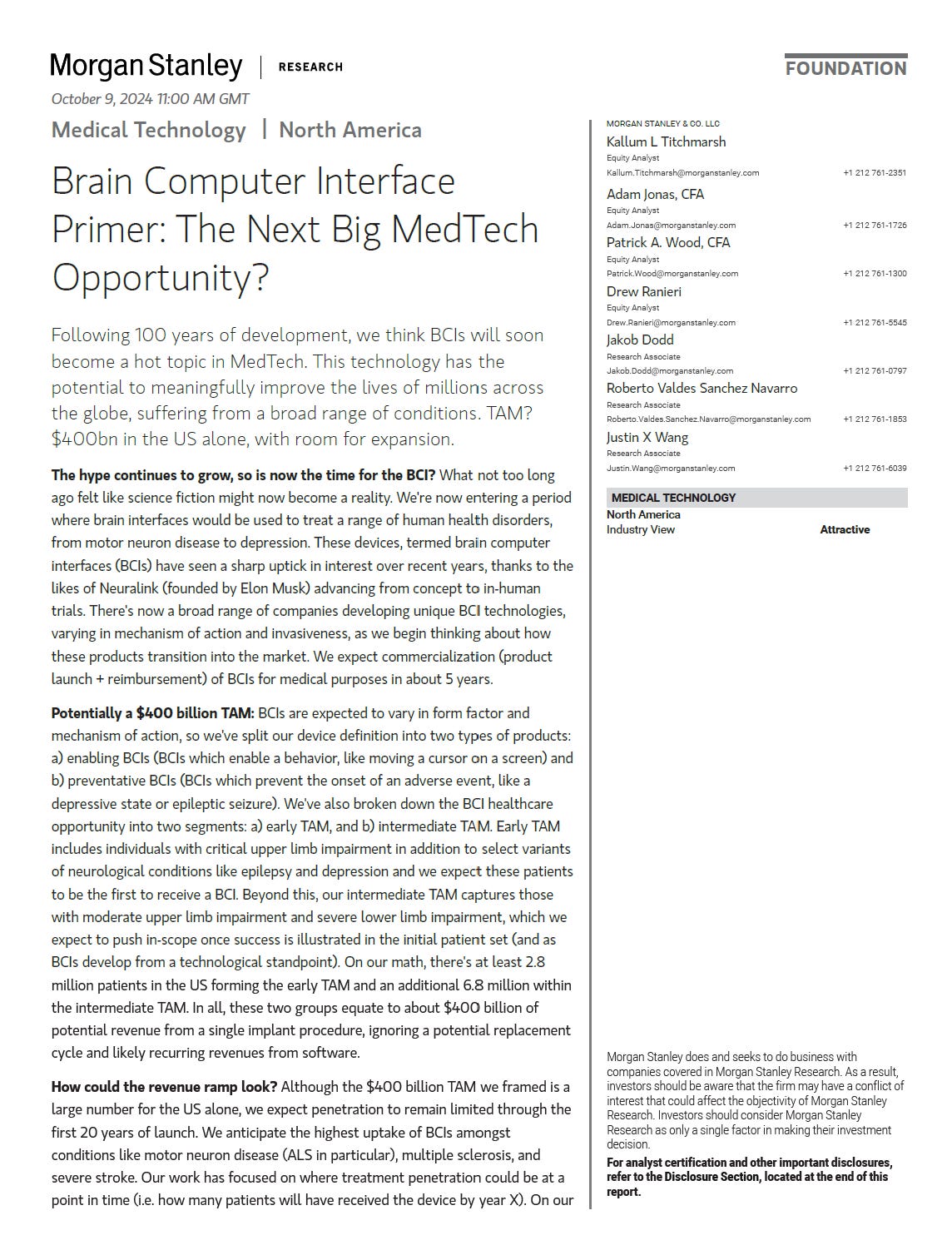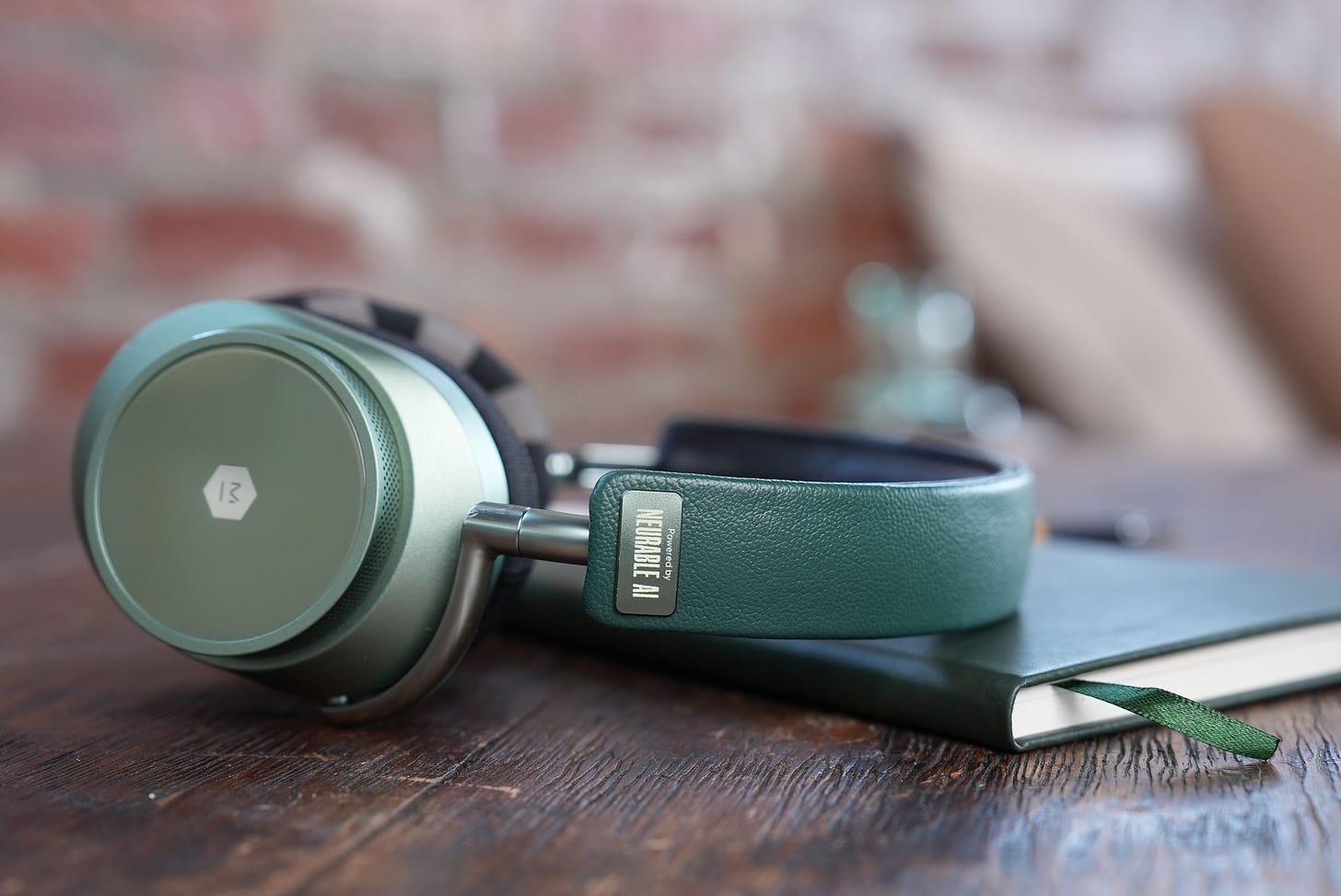The BCI Gold Rush: Morgan Stanley’s Vision for a $400 Billion Future and more💡- Issue #12
Welcome to Neurotech Pulse - Issue #12! This edition highlights key insights from Morgan Stanley's report, which estimates the U.S. BCI market could reach $400 billion. We also spotlight groundbreaking advancements in neurotechnology, such as Precision Neuroscience's Layer 7 Cortical Interface unveiled at Neuroscience 2024, Sonera’s Magnetic Muscle Sensing technology for enhanced gesture control, and Stanford’s innovative use of ultrasound for brain therapy. Additionally, the newsletter examines the rapid growth of the wearable neurotech market and ongoing challenges in empowering individuals with disabilities, alongside significant research linking dopamine pathways to movement and motivation.
Join us as we explore these advancements, educational opportunities, and resources shaping the future of neurotechnology!
📈 Insights on the BCI Market Landscape
In our continuous effort to keep you informed about significant developments in the BCI landscape, we highlight key insights from a recent report by Morgan Stanley.
The report sheds light on the promising trajectory of the Brain-Computer Interface (BCI) market. Entitled “Brain-Computer Interface Primer: The Next Big MedTech Opportunity?,” it underscores a significant potential, estimating the U.S. BCI market could reach approximately $400 billion.
Key Findings:
Market Potential: The report outlines the Total Attainable Market (TAM) into an early TAM of $80.8 billion and an intermediate TAM of $320 billion, identifying nearly 10 million potential candidates across the U.S.
Target Indications: Noteworthy conditions for BCI adoption include ALS, stroke, spinal cord injury, and epilepsy, suggesting considerable revenue potential in the forthcoming years.
Commercial Outlook: The report anticipates commercial activities and product launches may materialize within the next five years, projecting a cumulative revenue of $1.5 billion over the subsequent decade.
Catalysts for Growth: Influential factors such as demographic shifts, evolving regulatory landscapes, and enhanced clinical outcomes assessments are expected to progressively boost market engagement.
This analysis emphasizes the importance for stakeholders to understand the intricacies of market evolution, especially as the BCI sector is set to experience significant growth in the near future. For a deeper exploration of these insights, we encourage engagement with ongoing industry discussions and resources. (Learn more)
🧠 Neurotech Trends:
Breakthrough in Brain-Computer Interface Technology: A New Era of Neural Decoding at the Society for Neuroscience Annual Meeting, Neuroscience 2024: At the Neuroscience 2024 conference, Precision Neuroscience introduced the Layer 7 Cortical Interface, a minimally invasive BCI implant with 1,024 electrodes. This advanced technology captures high-resolution neural activity from the brain's motor cortex, which controls movement. By providing unprecedented insights into beta oscillations—brainwaves critical to movement—the Layer 7 Interface allows researchers to map real-time brain activity during motion. This breakthrough could transform treatments for paralysis and motor impairments, potentially allowing patients to control robotic limbs using just their thoughts. (Learn more)
Magnetic Sensing for Human-Computer Interaction: Sonera is pioneering Magnetic Muscle Sensing (MMG) technology, which could reshape gesture-based control for wearable devices. Their S1 chip enables high-fidelity muscle activity tracking, offering more precise and universal gesture recognition than existing methods like cameras or electrical sensors (sEMG). This breakthrough promises to improve user experiences in augmented reality (AR), virtual reality (VR), and other immersive technologies by providing natural, seamless controls without needing environmental adjustments. Wrist-based devices, like smartwatches, are especially suited for MMG, with the potential for expansion into smart glasses and earbuds for facial gestures or sub-vocal control. Sonera’s work marks a significant step toward more immersive and accessible interfaces for personal computing. (Learn more).
Stanford’s Sonic Revolution: Healing the Brain With Ultrasound: Researchers from Stanford University and the University of Plymouth are leading a transformative approach to brain therapy through transcranial ultrasound stimulation (TUS). This non-invasive technique allows for precise targeting of specific brain areas to treat conditions such as chronic pain, OCD, and Parkinson’s disease. By moving ultrasound from a diagnostic tool to a therapeutic innovation, TUS has the potential to serve as a home-use device, making brain therapy more accessible to individuals. The technology not only facilitates targeted treatment but also functions as a “search and rescue tool” for identifying areas of concern in the brain. While challenges remain in personalizing the approach for diverse brain anatomies and ensuring affordability, the integration of TUS with emerging brain-computer interfaces could redefine interactions between the brain and technology, positively impacting millions. (Learn more)
📘 Neurotech Articles:
How a MedTech market opportunity is shaping up for wearable neurotech: The wearable neurotech market is poised for substantial growth, driven by technological advancements and increasing demand for personalized healthcare solutions. The article highlights how innovative companies are developing neurotechnology applications that range from stress management to sleep improvement. With the rise of mental health awareness and the integration of neurotech into consumer products, the market is expected to see significant investment and expansion. Furthermore, regulatory approvals and partnerships with established healthcare providers will enhance credibility and facilitate broader adoption. This evolution presents exciting opportunities for entrepreneurs and investors in the wearable neurotech sector, as the convergence of healthcare and technology transforms patient care and wellness. (Read more)
Beyond Neurotech: Limits of BCI For People With Disability: This article explores the untapped potential and systemic challenges in using Brain-Computer Interfaces (BCI) to empower individuals with disabilities. It details the story of Tabi Haly, a software engineer with spinal muscular atrophy, who navigates an outdated Medicaid system to access necessary care. The piece raises key questions about how BCI technology might reshape the workforce but also emphasizes that without healthcare and policy reforms, the technology alone won't be enough. It calls for BCI companies to think beyond technological innovation and engage in efforts to reform disability support systems, making BCI a true enabler of autonomy and inclusion. (Read more)
Neural Pathways Link Dopamine to Movement and Motivation: MIT researchers have identified two new brain pathways in the striatum that control dopamine release, impacting movement and emotional decision-making. These pathways regulate the balance between movement initiation ("go") and suppression ("no-go") by either stimulating or inhibiting dopamine production. The findings shed light on how dopamine influences decisions tied to strong emotions, such as anxiety, and could have implications for treating movement-related disorders like Parkinson’s disease. This discovery challenges existing models of brain function and opens new avenues for understanding the brain's role in motivation and movement. (Read more)
What is wearable neurotech and why might we need it: The wearable neurotech market is making strides in mental health treatment, offering non-invasive solutions for conditions such as depression, anxiety, and sleep disorders. Companies like Flow Neuroscience and Neurovalens are developing devices that provide therapeutic benefits without the side effects of traditional medications. As mental health awareness grows, these technologies receive increased attention from consumers and healthcare providers alike. Although regulatory challenges remain, recent approvals signal a broader acceptance of neurotech within healthcare. This trend highlights the potential for wearable neurotechnology to become a mainstream mental health treatment option, opening doors for innovation and investment in this growing field. (Read more)
🌐 Neurotech Edu. and Events:
BCI Neurotech Masterclass Hong Kong 1.0 (Online)
Date: November 19, 2024
Why Attend the Event?
This masterclass covers a range of topics from neurolinguistics to neurorehabilitation, featuring insightful presentations on the latest advancements in BCI applications, including functional mapping, EEG technology, and innovative rehabilitation methods. Engage in discussions that could shape the future of neurotechnology!Link to Register: Register Here
2024 Neurotech Leaders Forum (Embassy Suites, San Francisco Airport Waterfront)
Date: November 6-7, 2024
Why attend the event?
This two-day conference will bring together executives and entrepreneurs from the neurotechnology industry to discuss advancements in neuromodulation, neuroprosthetics, neurodiagnostics, and neurorehabilitation. The forum will feature presentations from leading researchers and entrepreneurs.Link to Register: Register Here
🎬Case Studies
Case Study Spotlight: Neurable’s MW75 Neuro – Merging Neurotechnology with Premium Listening Experiences
In this edition's case study spotlight, we explore Neurable and its collaboration with Master & Dynamic, which resulted in the MW75 Neuro. Neurable, founded in 2015 by Ramses Alcaide, James Hamet, and Adam Molnar, is at the forefront of neurotechnology, creating tools that measure emotions, interpret user intent, and enable interaction with digital environments through thought. The MW75 Neuro, developed in partnership with Master & Dynamic is a blend of adaptive noise-canceling headphones and brain-computer interface technology, offering a premium listening experience infused with neurotechnology.
Overview: The MW75 Neuro represents a breakthrough in consumer electronics, combining Master & Dynamic’s expertise in high-quality audio with Neurable’s brainwave monitoring technology. This wireless headset leverages EEG sensing to help users enhance their focus, avoid burnout, and boost productivity. It is equipped with intuitive Active Noise Cancellation (ANC), offering tailored listening experiences while integrating neurotechnology for emotional and cognitive state awareness. With a focus on consumer use, the MW75 Neuro is designed for everyday tasks and work environments, offering a seamless blend of luxury audio and practical neuro-enhancement.
Use Case Highlights:
Real-Time Focus Monitoring: The MW75 Neuro leverages advanced EEG technology to continuously monitor and analyze brain activity. This feature allows users to gain real-time insights into their cognitive state, helping them understand when they are most engaged or distracted. By visualizing their focus levels through the Neurable app, users can make informed adjustments to their work habits, fostering a more effective and mindful approach to their daily tasks.
Hands-Free Device Control: The MW75 Neuro enables hands-free interactions with devices through cognitive commands. For instance, a focused thought can skip a track or adjust the volume while listening to music. This capability streamlines the user experience, allowing for multitasking without physical interaction, which is especially beneficial during commutes or busy work environments.
Target Audience: The MW75 Neuro targets professionals, productivity enthusiasts, and neurotechnology researchers, as well as everyday users seeking to enhance focus and prevent burnout. It appeals to those in high-stress environments, including creative professionals, corporate workers, and developers, looking for a device that combines premium audio with neurotechnology benefits. Additionally, it serves students and educators, promoting mindfulness and mental wellness through intuitive technology.
Key Partnerships:
Neurable’s innovative advancements are supported by a diverse network of partnerships across various sectors, including military organizations, academic institutions, and consumer electronics brands. These collaborations facilitate the development and refinement of products like the MW75 Neuro, pushing the boundaries of neurotechnology in enhancing cognitive performance and mental well-being.
Led by Ramses Alcaide and Adam Molnar, Neurable aims to integrate brain-computer interface technology into everyday applications, empowering users to better manage stress, improve focus, and achieve greater productivity.
To explore the MW75 Neuro and its potential applications, visit Neurable
🌟 Nexstem Announcements
Neurotech Pulse Special Edition: Call for Contributions!
Calling all researchers and writers! Want to showcase your work in our upcoming Neurotech Insights edition? Reach over 5,000+ neurotech enthusiasts by sharing your innovative research. Submit your details and work to saman.nawaz@nexstem.ai
Introducing the BCI Kickstarter Series!
Join us as we launch the BCI Kickstarter — a weekly blog series that takes you from zero to one in understanding BCIs. Each post will break down core concepts, spotlight innovations, and uncover the latest trends shaping the future of neurotechnology.
💡Question:
Results of Previous Poll:
What do you think is the most underrated application of EEG technology today?Neuroeducation: 42%
Consumer Research: 38%
Creativity Enhancement: 5%
Mindfulness Training: 15%
❤️ Join us on Discord.
Thanks for reading Neurotech Pulse! Subscribe for free to receive new posts.





